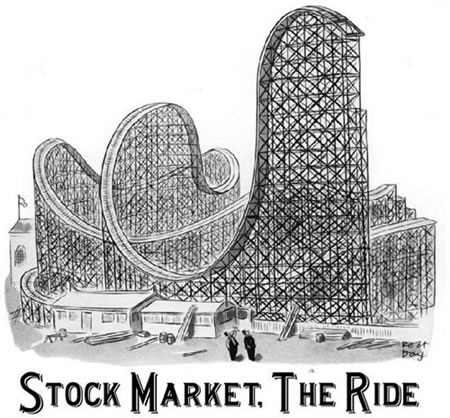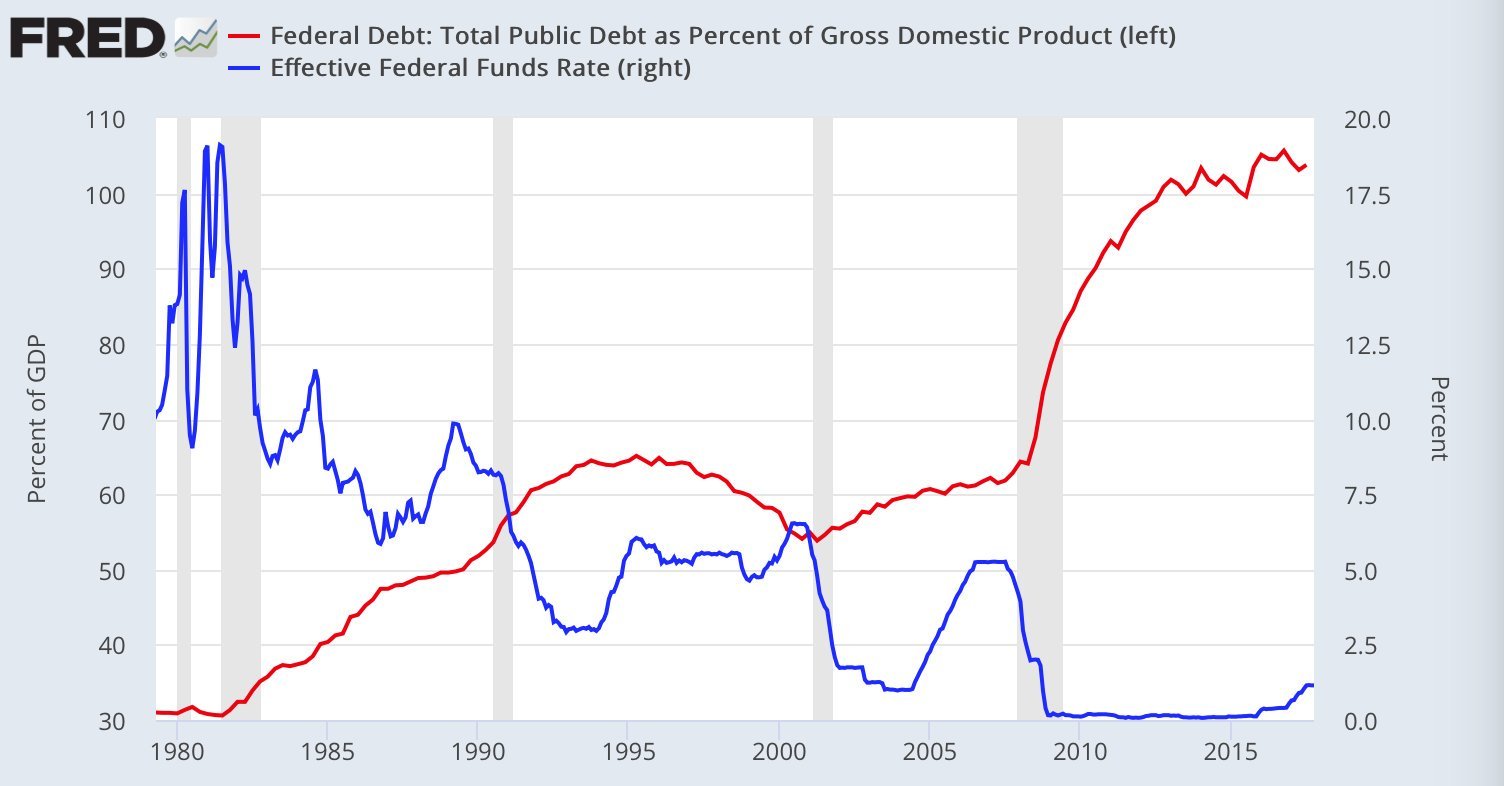
“The perfect storm” has become a cliché, but the current setup for a 2019 recession just became so text-book perfect in alignment of the three most critical recessionary forces that I have to use it.
Let me start by noting that a stock market that rallies because the news is bad — as happened a little over a week ago when we got a terrible new jobs number (only 75,000, less than half of the weak number economists expected and lower than what it takes just to keep up with population growth) — is a market that is locked in dependence on recovery-mode life support where everyone is happy just because the ambulance will soon be on its way … again.
That market as well as the “recovery economy” built around it is destined to fail because you cannot sustain growth or build enduring wealth on the need for an endless flow of bad news to keep forcing central banks to create new money in order to keep goosing the marketplace along. It’s a stock market running on absurdity. The need for endless salvation is not the hallmark of health. However, the market’s codependency on the Fed is not the set-up I’m talking about. It is merely evidence that this soaring market is not a healthy market. (A tree blooms most, you know, just before it dies.)
It is, however, exactly the kind of stock market we have become used to because the market has become addicted to Fed support (I’ll call it “Fedaid”) over the past decade. Because this abnormality (in a broader historic context) has become the new norm, investors fail to realize that this time is greatly different because of three truly significant situations in its setup that I’ll lay out below. This time, bad news is the worst of news, but the market — because of its decade of Fed-addled memory — completely fails to see the storm that is arriving all around it right now. That kind of blindness can also be the setup for one hellacious crash.

Market Mayhem sets up the 2019 recession
You see, investors think the market is plunging up and down on the waves because it is trying to break through a hardened ceiling that has held up for eighteen months. During those eighteen months, the market dropped off of three tops that were barely successively higher than each other (just enough higher each of the last two times to test whether going higher was possible and then fail).
Some of the market’s talking heads think the market is about to break through what they hope has become a brittle ceiling with a fourth push — this time for the big run into the heavens — if the market just gets a little Fed juice. The bad news about jobs was just the enticement they needed to restore hope that the Fed juice is coming. Others are starting to wonder what the rough ride is about. This time, the churn is not just because the market is attempting a fourth breakout. It is due to some deep developing issues setting up a situation where Fed juice at this particular time would be Jonestown Kool Aid®!
The sudden May pitching and yawing was caused by major winds now converging at our sorry location from three different directions. These three fierce forces have proven to be the major bellwethers of recessions, and they have just come into flawless alignment in their timing, which substantially improves the outlook for only one thing — my start-of-the-year statement that a 2019 recession will begin this summer (but not be officially known until next year just because of how recessions are measured and declared).
Things had been looking shaky for my 2019 recession prediction — its summer placement being far ahead of the entire market-prognosticating pack. The market experienced such clear sailing throughout the first four months of the year that even I began to wonder if I’d be wrong. However, market momentum turned negative in May for the first time since last September when the market crashed through December. It is not that turn, however, that makes me confident my prediction is going to be spot on. Big as that turn was, something bigger is behind it.
In fact, the S&P 500 return for the month of May was the worst since the flash crash of May 2010 and before that May 1962….
Zero Hedge
Something is different this time. Actually several things, but let me start with the surface thing (which is not one of the big three that I’m coming to, but still noteworthy in passing):
Goldman Sachs now says the strategy of “buy the dip” that worked during the years of Fedaid that followed the Great Financial Crisis looks increasingly risky as market fails become longer and deeper. Sachs of Gold suggests it may be time to switch to “sell the rip.” Not surprising since most indices entered a bear market last December, and some of them remain there — a problem all the talking heads seem willing to intentionally forget as they chatter and glow about the continuance of “the longest bull market in history.” So, let us just remember where we really are as the forces I am talking about play out. We’re in the belly of a bear. (We are still in a bear market in three of the most important indices — the Dow, the Russel 2000 and the NYSE.)
Juiced-up June
Now, here is the pivotal alignment that just happened, starting with the most recent force to come into play among the other two that I’ll remind you of:
#1. The first out of the three major forces is this: A few months ago, we had a yield-curve inversion (of the particular kind the Fed tracks as most reliable — the 3-month bill over 10-year bond). The Fed considers a yield-curve inversion and rise in unemployment after it bottoms to be two of the most reliable indicators of impending recession:
On average, since 1969, the unemployment rate trough occurred nine months before the NBER-determined recession trough, while the yield curve inversion occurred 10 months before. For both series, the maximum lead time is 16 months before the recession…. The minimum lead times were one month for the unemployment trough and five months for the yield curve inversion.
St. Louis Fed
That brings us to #2) Just as the market heated back up in June, we have come upon that other equally important inversion — the trough where unemployment bottoms out and begins to rise. Thus, the bad job print means the economy needs to see a Fed rate decrease. While that explains the levity in June over hope that the Fed will bring out the punchbowl, unfortunately the revelers do not know it will be the Jonestown punchbowl this time because …
US weekly jobless claims unexpectedly rise, sparking fears the labor market is losing steam…. The third straight weekly increase in claims suggests some softening in labor market conditions…. The four-week moving average of initial claims, considered a better measure of labor market trends as it irons out week-to-week volatility, increased 2,500…. The slowdown in hiring, which occurred before a recent escalation in trade tensions between the United States and China, raised fears of a sharp deceleration in economic growth. Data so far have suggested a sharp slowdown in U.S. economic growth in the second quarter after a temporary boost from exports and an accumulation of inventory early in the year. In addition to the sharp moderation in hiring last month, manufacturing production, exports and home sales dropped in April, while consumer spending cooled. The Atlanta Fed is forecasting gross domestic product increasing at a 1.4% annualized rate in the April-June quarter”
CNBC
I’m not ringing the alarm just because we had one low new-jobs number. What is significant is that the four-week unemployment claim trend, which averages out the anomalies, has finally turned back upward. Notice in the following graph by the Fed how recessions start immediately after the unemployment rate begins to rise again from its lowest trough:

That is about as dependable as clockwork gets, and that is where we are right now based on the above report above from CNBC. When that lines up in perfect timing with an interest-rate inversion, we have a serious situation forming. However, we have one other major factor that almost always precedes a recession
#3) While interest-rate decreases have been good for stocks over the past decade, that is only the case when they are happening on the way out of a recession. When rate decreases happen during the supposed time of full recovery after a period of rate increases aimed at stopping recovery from “overheating,” the first rate decrease is typically one of the best proofs there is that we are going back into a recession, and recessions are never good for stocks. (While stocks don’t always crash during recessions; they certainly never do well during recessions.)
As shown in my last article, recessions typically start after the Fed’s first rate decrease that follows a protracted period of post-recovery increases, usually after the Fed has paused at the top of those increases (as the Fed is now pausing):

Over the last fifty years, those interest-rate inflections have happened at lower and lower peak interest-rate levels. Interestingly, those rate decreases that preceded recessions also time out each time with the first clear inflection in the unemployment rate. And here we are today, with just such an unemployment inflection apparently manifesting right as everyone is expecting the Fed to gin up the economy by lowering interest rates.
Bringing the perfect storm together for a 2019 recession
With the yield curve having inverted to the Fed’s liking about five months ago and unemployment troughing right now, the quintessentially perfect setup for a 2019 recession as early as this summer would be for the Fed to lower rates in June or July! You see, a Fed rate decrease often precedes a recession by as little as a month or two.
The stock market is doing exactly what I have been anticipating over the last two months — mindlessly herding in the wrong direction and setting itself up for a devastating crash. This will be one more event in a “rolling bear market,” as JP Morgan has called it, where the bear will take, at least, two years to fully play out. However, whether the stock market crashes or not right now (and it doesn’t have to even in a recession, especially since it already did crash), we still have the perfect storm and alignment in time for a recession if the Fed brings in a rate decrease, which I think it will do in July, putting us in solid position for a recession starting near the end of summer (even sooner if the Fed makes its first interest-rate decrease in June).
Personally I prefer standing back and letting the lemmings go over the cliff by themselves; but I am not an investment adviser — just a guy who tracks and tells how the economy is going and how its going to go. Some people love a thrill ride, and a market like this is just the thing for them.
Absurd as it was that the market rose upon bad job news when we are supposedly enjoying a great economic “recovery,” it was also highly predictable based on how the market has been responding for the past decade to bad news as being good news because bad means more free Fed money.
While that has worked for the market during the years of Fedaid — and few butterfly investors today have a memory that goes back further than that even if they are old enough to know better — it is utterly ridiculous to be hopeful because of it in our present situation because the only reason the Fed would ever consider retreating so soon from its “normalization” plan would be if the economy was careening off a cliff into a recession, and stock markets ne’er do well in recessions!
As far as interest-rate cuts go, it is different this time than in the past ten years because this time, we are 1) about 5-6 months after the first interest inversion with many broader interest-rate inversions that have followed, 2) three weeks past the bottom of the trough in unemployment to where the average is now rising; and, so, if we now 3) get the Fed’s first interest-rate decrease following a pause in rate changes that follows a long period of interest-rate increases, we’ll have the perfect setup for a major fail. While it is an overused metaphor, that is truly THE PERFECT storm for the start of a recession in 2019.
Don’t “misunderestimate” the market’s madness
If the economy is so strong, as the popular market seers want to say, why do we need the Fed to leap in? Why is the lemming herd betting on 2-4 interest-rate cuts in this supposedly great year? Thing are not good, but the market is addicted to the Fed’s free money forever. Denial keeps pretending this is not just sick addiction. With so much denial yet to be broken, expect 2019 to do no better than 2018 and probably much worse.
Yes, the market did rise stratospherically in the first months of this year after falling by even more and then shot up again in June, just as it rose on hopium and crashed fairly spectacularly twice last year (three times if you count the devastating fall of the FAANGs by about 40% midyear). After all those ups and downs, here we are with the market exactly where the market sat a year and a half ago when I said its long, extraordinarily bouncy ride to nowhere and worse would begin. We’re now about to enter the worse part.
There will still be big rallies up and big busts down as investors get the sense knocked back into them the hard way over the course of the nexts two years. If you can always sell at each peak and buy at each trough, you’re brilliant and will make bank by knowing when the market is going to be stupid and getting out moments ahead of the lemmings. Because I’m near retirement, I don’t have the stomach for the risk, so I’m watching comfortably from the bleachers, drinking my 2% beer of cash and bonds as I avoid the Fed’s Kool Aid®.
Our strongest rallies often do come in bear markets because it is really hard to knock sense into the market bulls when they become bullheaded from years of success; so, don’t let anyone trick you into believing some steep rally means we’re heading back to the wild blue yonder. Right now, we all get to watch the market bounce up on Fed rate-cut hopes (Fedaid), fall on dashed hopes and then plunge when Chinese tariff news starts bringing in dismal economic numbers. We saw the first big difference Friday in China. (See my last article on all of that.)
On China’s side, global exports reported a major drop on Friday (tepid YoY growth of only 0.5% for May after an April decline of 3.3%). The worst part of the report, however, was Chinese industrial growth — at its worst in seventeen years, which pretty much takes us back to the days of peasant farmers wading in rice paddies.
While the US stock market rises and falls based on fickle hopes that such news means China will cave in on the tariff talks, the underlying cause of the market’s troubles is Fed tightening after way too much Fed loosening for far too long, global economic decline, and US economic decline due to a host of economic problems we kicked down the road for ten years because we either cannot see clearly enough to agree on them or we just don’t want to bear the pain of changing our ways. Now all of this is showing itself in the three big winds I just described, and China just adds to all of that but will be a major disappointment for a market already set up for recessionary failure.
So, expect more rallies of false hope followed by more spectacular crashes. That is how the Great Depression happened, too — big crashes followed by huge rallies followed by deeper crashes. Note, however that …
a rate cut after a long hiking cycle tends to be negative for stocks, in contrast to a pause like in January, which is typically positive.
Zero Hedge
Or, as David Rosenberg said, “You don’t go long the first rate cut, you go long on the last one.”
Consider this if you are still enamored of this year’s rally, if stocks are really doing so well, why is far more money flowing out of stocks and into safe-haven bonds and money-market funds in the past six weeks than has happened during this same period in any recent year? So much so, that yields on bonds are plummeting? The big question has been, which is right — the stock market or the bond market. (Hint: historically, the bond market has almost always been right.)


Virtually every asset but stocks is now pricing in a recessionary move. So which will be right? Euphoric US bulls or all other markets? I’m staying with my start-of-the-year prediction for a 2019 recession. I’ll let others drink the Fedaid when it comes, but don’t say I didn’t warn you about how that is the last drink you’ll take. Liked it? Take a second to support David Haggith on Patreon!
